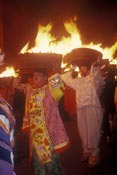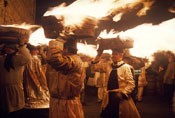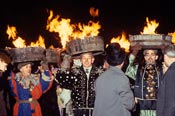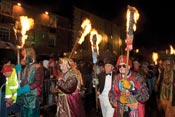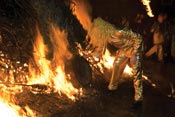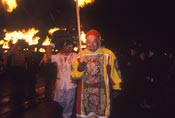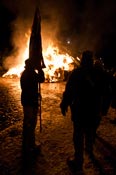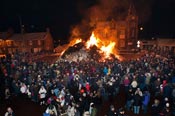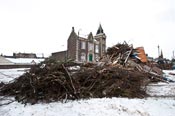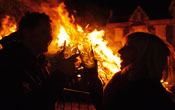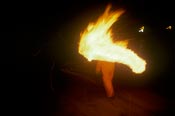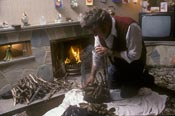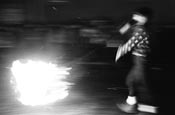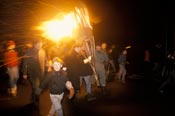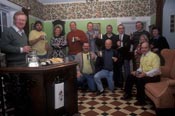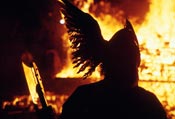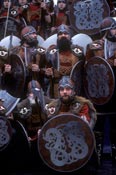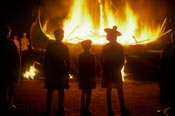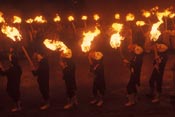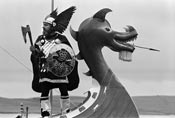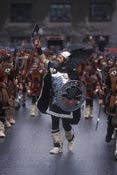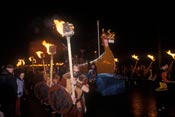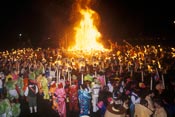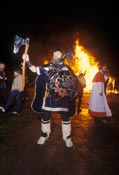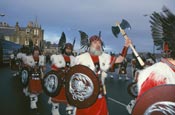
The next major outbreak of fire is on New Year’s Eve – and goes on almost to the end of January. The tar barrels come out again in Allendale, this time in sawn-off form on the heads of a procession of brightly costumed guisers who unload their burning embers onto a huge bonfire at the stroke of midnight. Biggar Bonfire is even bigger, accumulating for weeks as the locals get rid of cupboards, fences, pallets and any burnable rubbish too big for the bin. Stonehaven is more choosy because their ‘Fireballs’ have to be swingable and burn in exactly the right way. A fireball consists of inflammable but not too heavy material encased in a wire netting basket and attached to a wire handle. Up to 50 local men and women make these themselves and at midnight on Hogmany walk through the streets of Stonehaven swinging them around their bodies in a spectacular fiery procession, which ends after ten minutes or so with them hurling the remnants into the harbour. Not for the faint hearted. Even the spectators can be at risk. Comrie, to the west of Perth, also has an impressive ‘Flambeaux Procession’ – but none of our photographers has phographed it.
‘Old’ New Year is celebrated in Burghead by ‘Burning the Clavie’, a device made each year out of the bottom third of a barrel, so special that only locals are allowed to make it (with traditional tools including hand forged nails and a stone hammer), fill it, light it with smouldering peat, carry it burning around the town distributing good luck embers to designated householders, and finally place it to burn out on a permanent pedestal on Doorie Hill.
Up-Helly-Aa, on the last Tuesday in January in Lerwick, Shetland, is the most spectacular fire custom of all, involving 1000 guisers, all carrying flaming torches in procession behind their ‘Viking Galley’. Virtually the whole town joins in the parties afterwards. However, this successful custom is not that old. A longstanding midwinter festival, involving inevitable blazing tar barrels, was suppressed in 1874 due to ‘drunkenness and unruly behaviour’, but the Shetlanders were determined to have their fun and within seven years Up-Helly-Aa was born, to cock a snook at overbearing officialdom and at the same time celebrate their Viking inheritance. The Vikings invaded the Shetlands in the eighth century and ruled them until 1469. Lerwick is in any case closer to Bergen than Edinburgh so a ‘viking’ flavour is by no means inappropriate. However this reincarnation of Up-Helly-Aa came planned and organised and it has remained much the same ever since. Indeed it was so successful that imitation versions emerged, on other dates, in nine other locations among the Shetland Islands, from the second Friday in January at Scalloway until the third Friday in March at Delting.
Up-Helly-Aa day in Lerwick begins at 6 in the morning with the posting of ‘The Bill’, and ends at 6 the next morning after the parties in the Halls. The parade and the burning of the galley make an astonishing spectacle. However there is much more to it than that; Up-Helly-Aa lasts all year, with galley building, costume designing and making, meetings, fund raising events and the like. Being invited onto the 18-man committee means elevation to the cream of Lerwick society and leads, 18 years later, to the pinnacle of ‘Guizer Jarl’. It is more than just another custom, it is a crucial part of Lerwick life. Still it is worth pointing out that, though they have quite different ‘origins’, Up-Helly-Aa looks surprisingly similar to Lewes Bonfire Night 800 miles away to the south, while Comrie and Allendale are surely related. Hatherleigh and Ottery St Mary, on the other hand, seem more like the unruly affair that was Up-Helly-Aa before 1874.

